Spectroscopie, nature de la galaxie, expansion de l’Univers… Aux XIXe et XXe siècles, les découvertes s’accélèrent. Herschel, Einstein ou encore Hubble posent les bases des connaissances astrophysiques modernes et de la cosmologie
“Récif corallien cosmique” : la nébuleuse géante rouge NGC 2014 et sa petite voisine bleue NGC 2020 dans le Grand Nuage de Magellan, vues par le satellite Hubble pour ses trente ans en 2020. Crédit : Nasa/Esa/STScl
Nous sommes au début du XIXe siècle. La théorie de l’héliocentrisme qui défend que la Terre et les planètes sont en orbite autour du Soleil est acceptée. Mais depuis presque deux siècles, les découvertes scientifiques dans le domaine de l’astronomie se font au compte-gouttes.
Parmi les quelques faits remarquables tout de même, en 1755 le philosophe Emmanuel Kant tente pour la première fois d’expliquer la formation du Système solaire en utilisant la mécanique, et notamment les travaux de Newton. En 1769, l’explorateur James Cook effectue une mesure directe inédite : celle des distances Terre-Vénus-Soleil. Uranus est enfin considérée comme une planète grâce à l’astronome britannique Nevil Maskelyne, et William Herschel découvre en 1787 ses deux premiers satellites Titania et Obéron.
Fort Vénus, construit en 1769 à Tahiti par James Cook, à l’occasion de son voyage pour observer le transit de Vénus. Crédit : Charles Praval/H.D. Söring
Herschel met également en évidence le mouvement de translation propre du Soleil vers les constellations d’Hercule et de la Lyre, déduisant ainsi que le Soleil n’est qu’une étoile parmi d’autres, en mouvement à l’intérieur de la Voie lactée. Une perspective qui ouvre de nouveaux horizons dans la compréhension de notre Univers…
Stelvision








